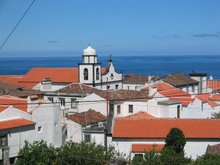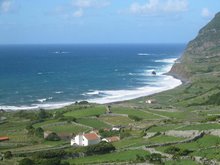... we're quite often asked "Do you ever see any ships going past?"
The answer to that is "occasionally, but not that often." About once a month, maybe, on average. And they're invariably so far away that they're just specks on the horizon - you can see them with the naked eye but for any kind of detail, I need to get out the "oculor" (= binoculors with one side broken. I refuse to buy another set as long as the remaining "oculor" continues to function perfectly well even if I do look like someone not quite right who's been let out for the afternoon when I'm using them (it)).
The ships we see are also invariably container ships. Shipping these days is terribly dull compared with previous decades. When I was a boy, the cargo ships that plied the oceans looked like this:-
 | |
| Picture credit David Christie |
But nowadays, the ships we see from our windows look like this:-
 | ||
| Picture credit Dominic Winsor |
Actually it's a coincidence the googled picture above is a CMA-CGM ship because we saw one of theirs going past here once, the letters on the hull being big enough to make out with the oculor. It's a big French shipping company and I went to their website and was able to work out from their schedules where it was going from and to. (It was news to me that container ships operate to schedules like car ferries.) I can't remember now exactly where but the screen grab below from Google Earth suggesting Le Havre from somewhere in South America rings a bell:-
From somewhere in the southern states of the USA ( I believe Savannah, Georgia is quite a big port) to the Straits of Gibraltar is also a candidate for passing our front door:-
I'm quite glad the passing ships don't get too close, though. A container ship called the CP Valour suffered engine failure off the Azores in 2005 and ran aground on the north coast of Faial. It couldn't be towed off and there was the inevitable release of fuel oil and many of the containers were knocked off and washed ashore (although no BMW motorbikes to be looted off the beach by the natives as with that ship - MSC Napoli, I think - that went aground on Cornwall (England) a couple of years ago and caused a lot of extra work for Her Majesty's Receiver of Wrecks in the public education arena).
The official salvors of the CP Valour didn't have much luck either. They spent months removing the remaining containers and the superstructure of the ship with a view to lightening the load to be able to refloat the hull and tow it away for salvage but, as I recall, they got the hull off but it sank into deep water barely a kilometre or so off the coast!
Of course, the CP Valour wasn't the first ship to be wrecked on the Azores. In 1909, the Cunard liner Slavonia was steaming east across the Atlantic from New York bound for Trieste when it is said that some of the passengers, keen to sight the Azores, asked the captain to alter course. The request was acceeded to but they ended up getting a closer view than they bargained for:-
More recently, in 1965, a ship called the Papadiamandis was wrecked right here at Faja Grande while en route between New Orleans and Hamburg:-
Recognise anyone? More pictures of that event at Memorias d'um Povo which is a great source of old pictures of Flores.
STOP PRESS - I started writing this last night and what happens this evening but a ship went by, passing from west to east. First time this year, I think - maybe the second. Photo below - even zoomed to the 12x limit of my camera, you'll have to take my word for it that that's a fully laden container ship:-













2 comments:
Hi, I can't find any contact info for you so apologies for using the comment section to get your attention.
I'm going to be in Flores (my birthplace) for first time in 28 years, having left there in 1967. I am desperate for some info/help about small local things, and I will gladly trade you 3 x NY Times newspapers, magazines, Skippy Peanut butter, or whatever else that you may be craving from USA. Please let me know if you are willing to have some short email correspondence with me, I promise to not take advantage of your kindness :)
lookoutkitty@gmail.com
Re bottom photo: Are you sure that wasn't just Corvo floating past?
On a serious note, I seem to recall Alfred Lewis describing in his semi-autobiographical novel "Home is an Island" how a German ship shipwrecked off the west coast of Flores (probably at or near Fajãzinha) during WW I, and the German sailors thrashed through the surf onto land, where they were rescued by the locals -- who lived in such isolation from the rest of the world at that time that they had no idea there was a world war going on. Don't know whether Lewis invented this episode, or if it's true -- perhaps someone there can tell you. Marisa, have you ever heard such a story?
Post a Comment